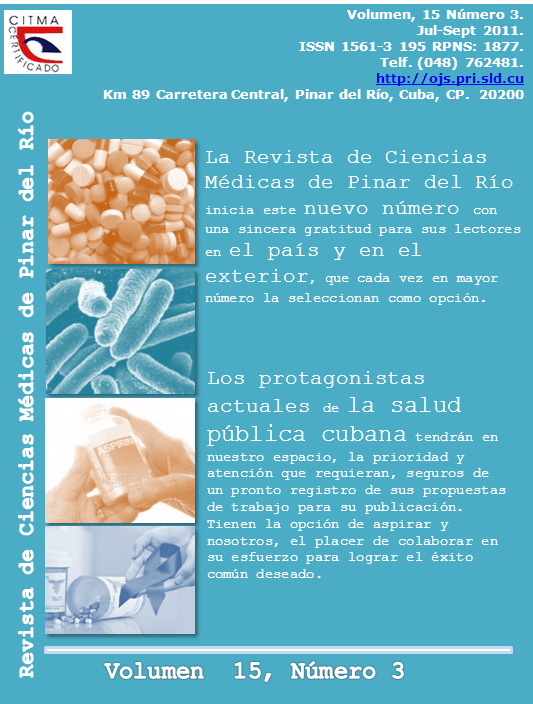Identification of learning needs concerning sexually-transmitted infections
Keywords:
Sexually transmitted diseases/diagnosis/complications, Learning..Abstract
Objective: to identify learning needs regarding the diagnosis and treatment of sexually-transmitted infections in residents and specialists in Primary Health Care. The lack of knowledge observed in offering health care to patients suffering from sexually-transmitted infections in communities was the inspiration of this study.Method: educational research in post-graduate area with a qualitative and quantitative approach in a target group of 22 medical doctors, residents and specialists in Comprehensive Medicine (Cuban and Venezuelan) who offer their services in "Barrio Adentro 1" which is located in Biruaca municipality, Apure State during 2010. Theoretical methods used along the research to sum up and understand information were: analysis and synthesis as well as empiric methods: a structured survey with open and close questions, semi-structured interviews to four key informers and to an expert. Data were given in absolute and relative values; results were expressed in statistical tables.
Results: the highest number of those interviewed showed insufficient knowledge regarding the diagnosis and treatment of sexually- transmitted infections, a high percentage enrolled update courses between 3 and 4 years after graduation.
Conclusion: the learning needs identified were related to: difficulties in the information records, physical examination, diagnosis and treatment of the sexually-transmitted infections.
Downloads
References
1.Gilson RJC, Mindel A. Sexually transmitted infections. medical journal 2008; 322(1160):-1164-998.
2. UNAIDS. Report on the Global AIDS Epidemic. Geneva: UN, 2007.
3. UNAIDS. Aids Epidemic Update: December 2002 [Internet]. USA: UN; 2009. Disponible: http://www.unaids.org/html/pub/Topics/Epidemiology/RegionalEstimates2002_en_pdf.htm
4. WHO. Global prevalence and incidence of selected curable sexually transmitted infections. Overview and estimates. Geneva: World Health Organization; 2008.
5. Gerbase AC, Rowley JT, Heymann DH, Berkley SF, Piot P. Global prevalence and incidence estimates of selected curable STDs. Sexually Transmitted Infections. 2007; 74(S):S12-6.
6. Salas Perea RS. La identificación de necesidades de aprendizaje. Rev Cubana Educ Med Super. 2003; 17(1):25-38.
7-Schmid G. Tratamiento de la tricomoniasis en las mujeres: Comentario de la BSR (última revisión: 28 de julio de 2007). La Biblioteca de Salud Reproductiva de la OMS; Ginebra: Organización Mundial de la Salud.
8. Kekki M, Kurki T, Pelkonen J, Kurkinen-Raty M, Cacciatore B, Pavoneen J. Vaginal clindamycin in preventing preterm birth and peripartal infections in asymptomatic women with bacterial vaginosis: a randomized, controlled trial. Obstetrics & Gynecology 2008; 97(5 Pt 1):643-8.
9. Schmid G, Narcisi E, Mosure D, Secor WE, Higgins J, Moreno H. Prevalence of metronidazole-resistant Trichomonas vaginalis in a gynecology clinic. Journal of reproductive. 2001 Jun;46(6):545-9.
10. Siegfried N. Nonoxinol-9 para prevenir el contagio vaginal de la infección por VIH de hombres a mujeres: Comentario de la BSR (última revisión: 25 de septiembre de 2003). La Biblioteca de Salud Reproductiva de la OMS; Ginebra: Organización Mundial de la Salud.
11. Walker G. Intervenciones para la tricomoniasis durante el embarazo: Comentario de la BSR (última revisión: 27 de agosto de 2004). Biblioteca de Salud Reproductiva de la OMS; Ginebra: Organización Mundial de la Salud.
12. McDonald H, Brocklehurst P, Parsons J. Antibióticos para el tratamiento de la vaginosis bacteriana en el embarazo. Reproducción de una revisión Cochrane, publicada en The Cochrane Library 2006, Número 4. Biblioteca de Salud Reproductiva de la OMS; Ginebra: Organización Mundial de la Salud.
13. Klebanoff M, Hauth J, MacPherson CA, Carey J, Heine R, Wapner R et al. Time course of the regression of asymptomatic bacterial vaginosis in pregnancy with and without treatment. American Journal of Obstetrics and Gynecology 2006; 190:363-70.
14. Leitich H, Bodner-Adler B, Brunbauer M, Kaider A, Egarter C, Husslein P. Bacterial vaginosis as a risk factor for preterm delivery: a meta-analysis. American Journal of Obstetrics & Gynecology 2006; 189(1):139-47.
15. Yudin MH, Landers DV, Meyn L, Hillier SL. Clinical and cervical cytokine response to treatment with oral or vaginal metronidazole for bacterial vaginosis during pregnancy: a randomized trial. Obstetrics & Gynecology 2008; 102(3):527-34.
16. Steyn PS, Odendaal HJ, Schoeman J, Stander C, Fanie N, Grove D. A randomised, double-blind placebo-controlled trial of ascorbic acid supplementation for the prevention of preterm labour. Journal of Obstetrics and Gynaecology 2003; 23(2):150-5.
17. Review Manager (RevMan). 4.1 for Windows Edition. Oxford, England: The Cochrane Collaboration, 20010.
18. McDonald H, Brocklehurst P, Parsons J, Vigneswaran R. Antibiotics for treating bacterial vaginosis in pregnancy (Cochrane Review). In: The Cochrane Library, 3, 2004. Chichester, UK: John Wiley & Sons, Ltd. CD000262.
19. Rosnes J, NICHD MFMU Network. Does vaginal ph or gram stain score alter the likelihood of successful metronidazole treatment of bacterial vaginosis (bv) or trichomonas vaginalis (tv) during pregnancy [abstract]. American Journal of Obstetrics and Gynecology 2006;187(6 Pt 2):S228.
20. Goldenberg RL, Klebanoff M, Carey JC, MacPherson C. Metronidazole treatment of women with a positive fetal fibronectin test resu result. American Journal of Obstetrics and Gynecology 2005;185:485-6.
Published
How to Cite
Issue
Section
License
Authors who have publications with this journal agree to the following terms: Authors will retain their copyrights and grant the journal the right of first publication of their work, which will be publication of their work, which will be simultaneously subject to the Creative Commons Attribution License (CC-BY-NC 4.0) that allows third parties to share the work as long as its author and first publication in this journal are indicated.
Authors may adopt other non-exclusive license agreements for distribution of the published version of the work (e.g.: deposit it in an institutional telematic archive or publish it in a volume). Likewise, and according to the recommendations of the Medical Sciences Editorial (ECIMED), authors must declare in each article their contribution according to the CRediT taxonomy (contributor roles). This taxonomy includes 14 roles, which can be used to represent the tasks typically performed by contributors in scientific academic production. It should be consulted in monograph) whenever initial publication in this journal is indicated. Authors are allowed and encouraged to disseminate their work through the Internet (e.g., in institutional telematic archives or on their web page) before and during the submission process, which may produce interesting exchanges and increase citations of the published work. (See The effect of open access). https://casrai.org/credit/



